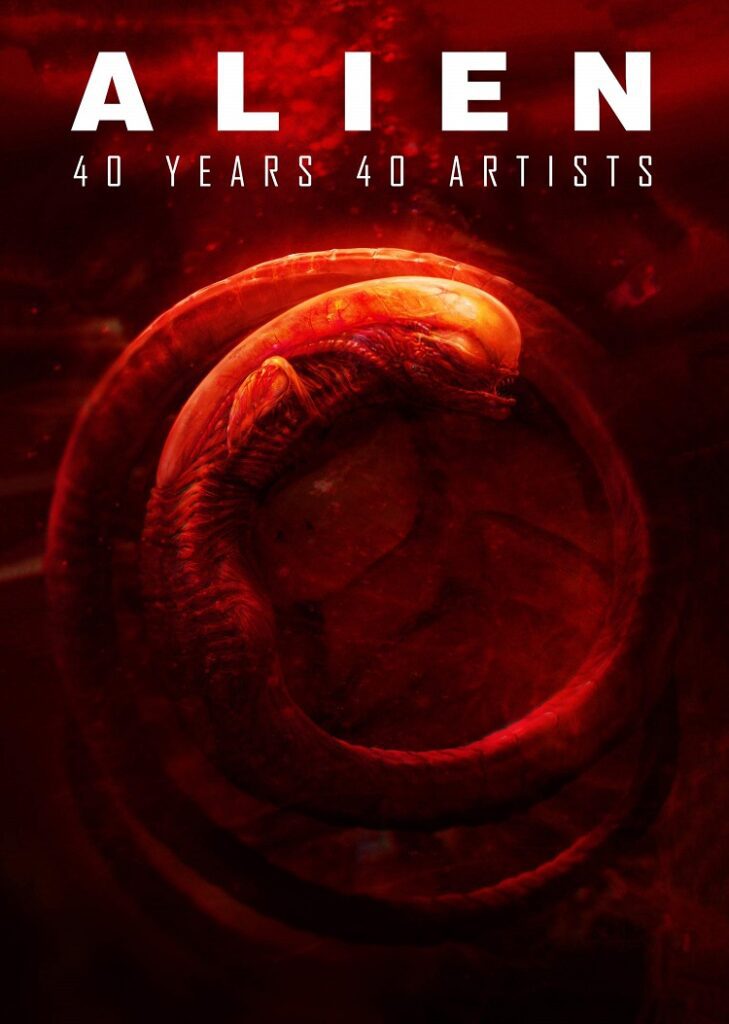
I took the opportunity to review Alien: 40 Years 40 Artists because I’m an Alien nut, then realized I don’t really know anything about art. Does it matter? Should it matter? If beauty is truly in the eye of the beholder, so what if I don’t know the correct technical terminology for the medium. You like what you like, right? Then I wondered if I even could fill a page with thoughts about a book of pictures. I did it before, but maybe that was easier because they were lighthearted Alien shenanigans. Well, here goes.
Alien: 40 Years 40 Artists is a celebration and tribute to the 1979 film that made science fiction history by positioning a blue-collar, middle income cast of characters opposite a monstrous but stealthy enemy from beyond, lending palpable horror to a genre that had become known for shiny space suits and absurdly googly-eyed rubber monsters. It was hard to take science fiction seriously at the time, but in the book’s foreword by Alien concept designer Chris Foss, he explains that the unexpected success of Star Wars gained Alien a much needed boost in credibility, care, and attention in bringing it to life. Of course, one of those movies is significantly more kid-friendly than the other.
While Alien and its successors have always been dark and bloody and violent, those weren’t the main appeal of the films, and this book does well in expressing that. I only recall two or three images that depict specific violence; the rest are spread across a broad range of themes, from highly interpretive designs that feature none of the iconic imagery of the franchise to a whimsical take that looks like the film could have been set in the same universe as The Jetsons. Yet they are all distinctly Alien even without referencing violent conflict. One piece is Mesoamerican themed, as if extracted from an archaeological endeavor, detailing the Alien life cycle. There are several alternative movie posters, but some of the most notable for me were the Weyland-Yutani recruitment/propaganda posters, using tongue-in-cheek phrasing and imagery clever enough that you might want to apply with the fictional company. Of course, no book about Alien — particularly one about art — would be complete without works from principal creature creator H. R. Giger, and he has his own section of works.
Variety is the key here. Some pieces show stark contrast, some great color and detail, some are abstract, or appear to have been savagely sketched out and colored in with a single pen. Some are minimalist with hidden details, and some take significant creative license with the material. A few merely suggest a moment from the original movie while others elicit strong memories of entire sequences with a single image, like Brett finding Jonesy in the room with the chains hanging from the ceiling along with…something else.
Media and materials also vary throughout. Many are digital paintings, some with incredible levels of detail and color vibrancy, but there are also pen and ink on paper, oil and acrylic on Bristol board, pencil and paint on canvas, and combinations of various techniques. Some are serene, some are daunting, and as mentioned earlier, a couple are positively gory — probably keep clear of the kids when flipping through it just to be safe.
Each author is given space next to their art to talk about how the Alien franchise has affected them over the years, as well as explaining how they created their art, specific influences as well as some desired interpretations and subtleties. At the end of the book is an index of the artists that includes links to their blogs, social media, IMDB pages, and other internet presences if you want to follow them or find out more about them and their work.
The hardcover book itself is in large coffee table format, the pages are thick, and it’s built to last. The diversification of material within makes it a real page-turning curiosity, and the quality of the build makes it a pleasure to hold and peruse. It may be of interest to artists and art lovers, but the primary draw is for fans of the Alien universe, and if you fall into the latter category, it deserves a space on your shelf.